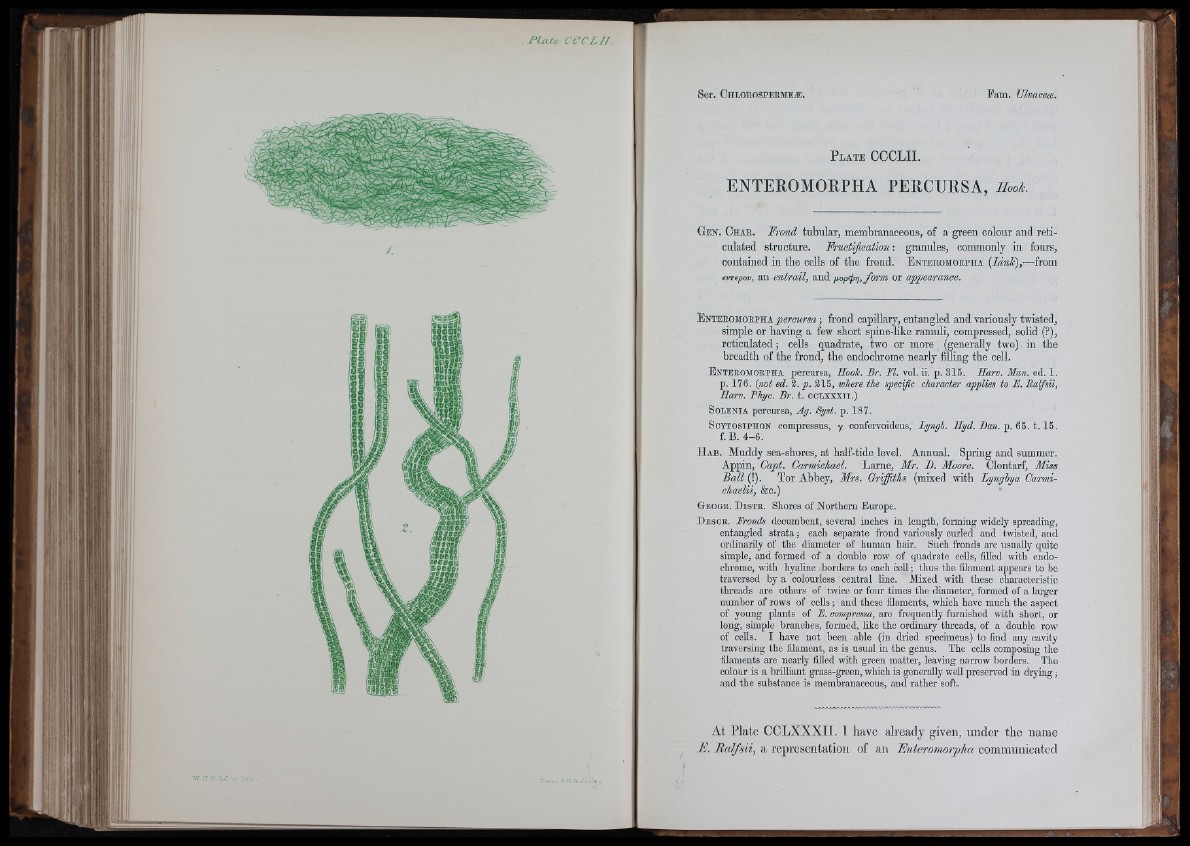
FUUe c c c zn .
P l a t e CCCLII.
ENTEROMORPHA PERCURSA, Hook.
G e n . Oh a e . Frond, tu b u la r , m em b ran a c eou s, o f a g r e en co lo u r and r e ticu
la te d stru c tu r e . Fructification: g ra n u le s, c om m o n ly in fours,
co n ta in ed in th e c e lls o f th e frond. E nt e eom oe ph a {Link),-— from
evrepov, an entrail, an d pop<fg,form or i
E nt eeom oeph a p ercursa ; frond capillary, entangled and variously twisted,
simple or having a few short spine-like ramuli, compressed, solid (?),
reticulated; cells quadrate, two or more (generally two) in the
breadth of the frond, the endochrome nearly filling the cell.
E n t e e om o e p h a percursa, Hook. Br. FI. vol. ii. p. 315. Harv. Man. ed. 1.
p. 176. (not ed. 2. p . 215, where the spedjic character applies to E. Balfsii,
Harv. Phyc. Br. t. CCLXXXII.)
Solenia percursa, Ag. Syst. p. 187.
ScYTOSiPHON compressus, y confervoideus, Lyngh. Hyd. Dan. p. 65. 1 .15.
f .B . 4 -6 .
H a b . Muddy sea-shores, at half-tide,level. Annual. Spring and summer.
Appin, Capt. Carmichael. Larne, Mr. D. Moore. Clontarf, Miss
B a ll (!). Tor Abbey, Mrs. Oriffiths (mixed with Lyn g lya Carmi-
Geoge. Dis t e . Shores of Northern Europe.
D esc e . Eronds decumbent, several inches in length, forming widely spreading,
entangled strata ; each separate frond variously curled and twisted, and
ordinarüy of the diameter of human hair. Such fronds are usuaUy quite
simple, and formed of a double row of quadrate cells, filled with endochrome,
with hyaline borders to each cell ; thus the filament appears to be
traversed by a colourless central line. Mixed with these characteristic
threads are others of twice or four times the diameter, formed of a larger
number of rows of cells ; and these filaments, which have much the aspect
of young plants of E. compressa, are frequently furnished with short, or
long, simple branches, formed, like the ordinary threads, of a double row
of cells. I have not been able (in dried specimens) to find any cavity
traversing the filament, as is usual in the genus. The cells composing the
filaments are nearly filled with green matter, leaving narrow borders. The
colom- is a brilliant grass-green, which is generally weU preserved in drying ;
and the substance is membranaceous, and rather soft.
At Plate CCLXXXII. I have already given, under the name
H. Ralfsii, a representation of an Enteromorpha cominunieatcd